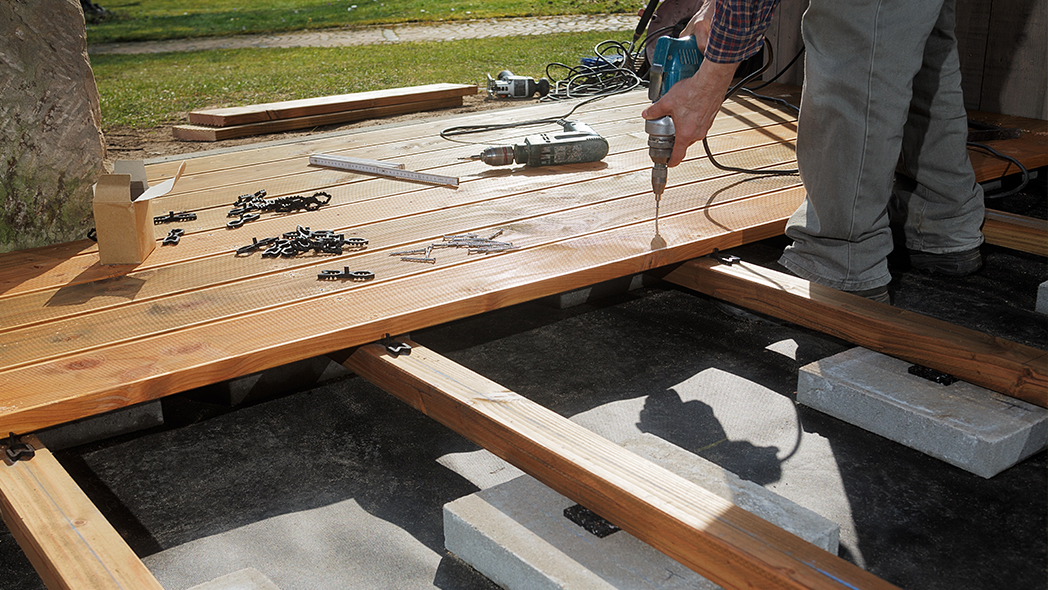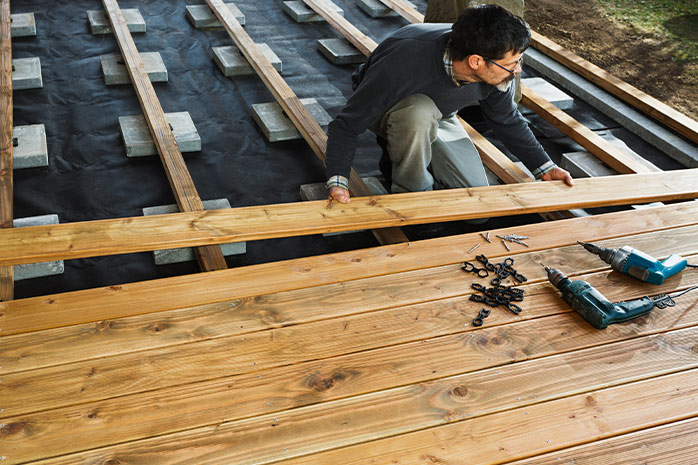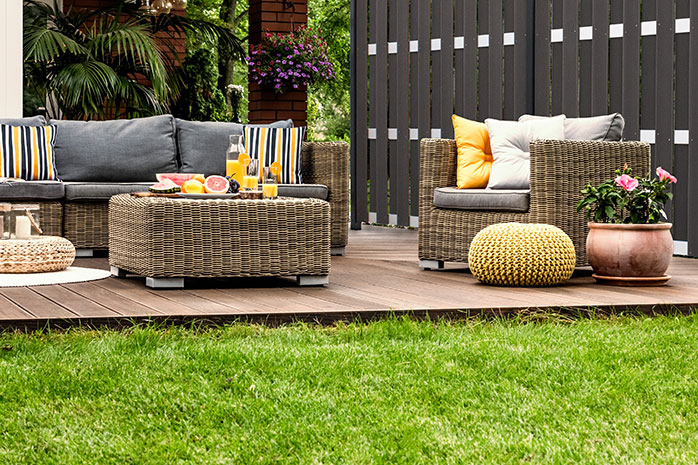
Photo: Ingo Bartussek / stock.adobe.com
Building a wooden deck on grass should be a well-planned project. We explain how you can build your own deck on grass and what special considerations need to be taken into account. If you want to build a DIY wooden decking on grass, you should plan ahead to ensure a smooth execution. Consider how large the deck should be and what material you want to use. For the DIY project "Build a Wooden Deck on Grass", these three points are essential:
- The prepared area (should be covered with weed control fabric),
- The substructure (foundation on, for example, gravel with supporting beams),
- The covering (decking boards).
Content
Fundamental for Deck Construction: The Appropriate Substructure
When you build your deck on grass, you should consider the following aspects in advance:
- Grass is an unstable foundation.
- Plants can grow in confined spaces.
- Drainage is necessary to prevent waterlogging.
For these reasons, you should avoid building your deck directly on the lawn. Settling soil and waterlogging would be the consequences that would damage your project in a very short time. You need to prepare the ground accordingly so that it can support the weight and allow water to drain away easily.
Unfortunately, there is no alternative to preparing the ground. Even building the deck with concrete slabs would damage the lawn and the structure in the long term. To have a good base for your wooden deck, you should opt for a substructure.
Building on beams is advisable. The supporting beams ensure sufficient distance between the foundation and the wooden boards. The substructure of the wooden deck is divided into three parts:
- Frost protection layer
- Support points
- Beam structure
Building a Deck on Grass: The Right Choice of Wood
If you want to build a deck on grass, you should choose high-quality decking boards. Local woods suitable for constructing a wooden deck include larch and spruce. These are very robust and durable.
Tropical hardwoods like Bangkirai have a longer lifespan but are significantly more expensive. The choice of wood should not depend solely on quality. The different shades of the various types of wood can also be a decisive factor in choosing a specific type.

DIY Wooden Decking on Grass: 5 Practical Steps
1. Mark the Deck Area on the Grass
If you want to build a wooden deck on grass by yourself, you must first plan the size. Pay attention to the width of the deck boards so that you do not have to cut any boards. Then you can stake out the desired deck area on the lawn by marking the corners with stakes.
2. A Slight Slope
Work with a string line, stretching it between the different stakes. The staked-out area is now rectangular. You can also mark the planned height with the string line. It is important to consider a slope of 1 to 2% so that rainwater can drain off the boards, ensuring you enjoy your wooden deck for a long time.
3. Excavate and Compact the Soil
Now you can remove the grass and part of the soil. The depth of the soil depends on whether the deck should be at the same level as the lawn or slightly above it.
In the next step, you can compact the excavated area. A vibrating plate is suitable for this. For uneven areas, you can use paving gravel. Once the ground is compacted, lay a weed control fabric to prevent grass and plants from growing through the deck.
When preparing loose soil, ensure stable support points. These ensure that the lawn soil does not sink. For this, dig holes with an area of about 20x20 cm, which are about 40 cm deep into the soil. Next, you can fill the holes with 10 cm of gravel and then compact them with damp concrete.
4. Place the Substructure
On the weed control fabric, place a foundation at regular intervals. You can recycle old paving slabs for this. An area of 3x3 metres requires about 20 foundation stones that need to form a level. To compensate for unevenness, you can distribute gravel on the weed control fabric, which also allows better water drainage.
Once the foundation is placed, follow with the supporting beams. For the above-mentioned area, you need five supporting beams, evenly distributed. Optionally, you can use support pads to protect the wood.
5. Lay the Deck Covering
After successfully laying the foundation, you can start laying the deck boards. Ensure there is a gap of several millimetres between the boards as the wood will expand. The deck covering is connected to the supporting beams. You can use stainless steel screws for this. The substructure, the right choice of wood, and the deck covering: with our effective tips, you can quickly realise your dream of building your own wooden deck on grass.

Experience the best service with planeo - because you need it!
No matter what challenges you face with your project, planeo provides you with the right solution. Benefit from the advantages of our services:
- Free samples⁴ for many of our products: Order up to 7 samples at no cost, for instance, such as our wooden decking or WPC decking.
- Express delivery² - for urgent projects and quick decisions.
- Expert advice¹ - We offer professional consultation through our contact page or answer your questions directly in the comments.
These topics might also interest you
Building a Raised Deck: Follow Our Step-by-Step Guide
Cleaning Bankirai Decking: 3 Simple Methods
WPC decking boards test – 7 reasons for TITANWOOD WPC boards
WPC terrace: ideas for a successful design
Terrace ideas: Inspiration and images for your outdoor dream
Building a wooden terrace: Everything about costs, construction and assembly